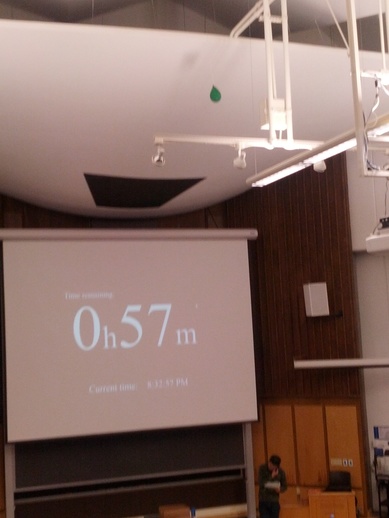Announcing the Exam Timer
Posted by David Zaslavsky on — CommentsFunnily enough my fluff post on exam proctoring got a good response on Facebook. I guess I should write more fluff. But for now, more on exam proctoring.
A few years ago I was bored while proctoring some exam — what a surprise — and my mind drifted to thinking about the exam clock. Or the lack of one, really. Our exam rooms don’t have a clock positioned where the students can see it, but they need to know how much time is left in the test, so we would usually put up the official NIST/USNO time page on a projector.

The problem is, this page is full of “junk.” It has a world map with day and night regions indicated, the date, assorted buttons and explanatory text, and in general all sorts of features that are not the one thing a test-taking student wants to know: how much time is left?
In those days I had the luxury of being bored even after the exam was over, so I whipped up a small web app to display a countdown to the end of the exam. And nothing else.

It was an instant success, in the sense that it was a functioning clock. Hooray me.
There is actually an interesting story here, though. A lot of thought went into designing the exam timer over the years, and nearly every feature has a purpose:
- The timer starts and ends automatically, which ensures that different rooms will start and end at the same time. (Although this one time
at band campI was proctoring in a room which was double-booked, so we had to move everyone across the street. Hacking the timer to account for the 5-minute delay we incurred proved to be problematic. I forget why I didn’t just make a new timer.) - Before the scheduled beginning of the test, the page displays instructions for the students to see while they’re filing into the room, as well as a clock so they can see when the test is about to start.
- It only uses black and white, because bright colors can be distracting.
- The one essential piece of information, the remaining time, is in a huge font. If you only see one thing on the page, it will be that. The font size is calibrated to fill up most of the screen at 800 by 600 resolution, which is what a lot of projectors still operate on.
- It only displays the hour and minute remaining, because quickly changing large digits can also be distracting, and you don’t need to know to the second how much time is left.
- It always rounds the remaining time down, unlike most other countdown timers. For example, a typical timer flips from 11m to 10m at the moment when there are exactly 10 minutes remaining. But in that system, for most of the minute that 10m is displayed, you actually have less than 10 minutes left. In a test, you’d rather think you have less than 10 minutes and then find out near the end that you have a few extra seconds, so this timer flips from 10m to 9m when there are exactly 10 minutes remaining.
-
It switches from hour:minute display to minute:second display when there are exactly 11 minutes left. Why 11? Well, proctors often want to give a verbal “10 minutes left” notice. I found that most people would do this when the timer flips from 11m to 10m. Fair enough; that’s how most timers work. But since this timer rounds down, it flips to 10m when there are 11 minutes left, and thus proctors wound up giving their verbal 10 minute notice a minute early. Changing to minute:second display a minute before the 10-minute notice decisively solved that issue.

minute:second countdown -
It flashes the screen and then fades back to black each second for the last 20 seconds. This seems to subconsciously grab students’ attention enough that they’re not completely surprised when the time ends, but it’s subtle enough not to be disruptive.

flashing -
As the timer reaches zero, the color scheme of the whole screen is inverted: the background is now white and the text is black, which visually emphasizes the change from “exam not over” to “exam over.”

timer over I’m there’s some psychological term for this. Pretend I used it so I look smart.
I’ve been using this little summer project for about 4 years now, as have several other proctors, and I think it’s actually turned out to be pretty useful. Some aspects are sort of specific to Penn State physics exams, like the instructions at the beginning, but that can be changed, and they’re pretty generic anyway. So I’m opening this up to the world. I’m proud to announce that the Exam Timer is now accessible on examtimer.org. I look forward to your feedback and suggestions for improvement in the comments!

And no, I still don’t know why there was a balloon on the ceiling.